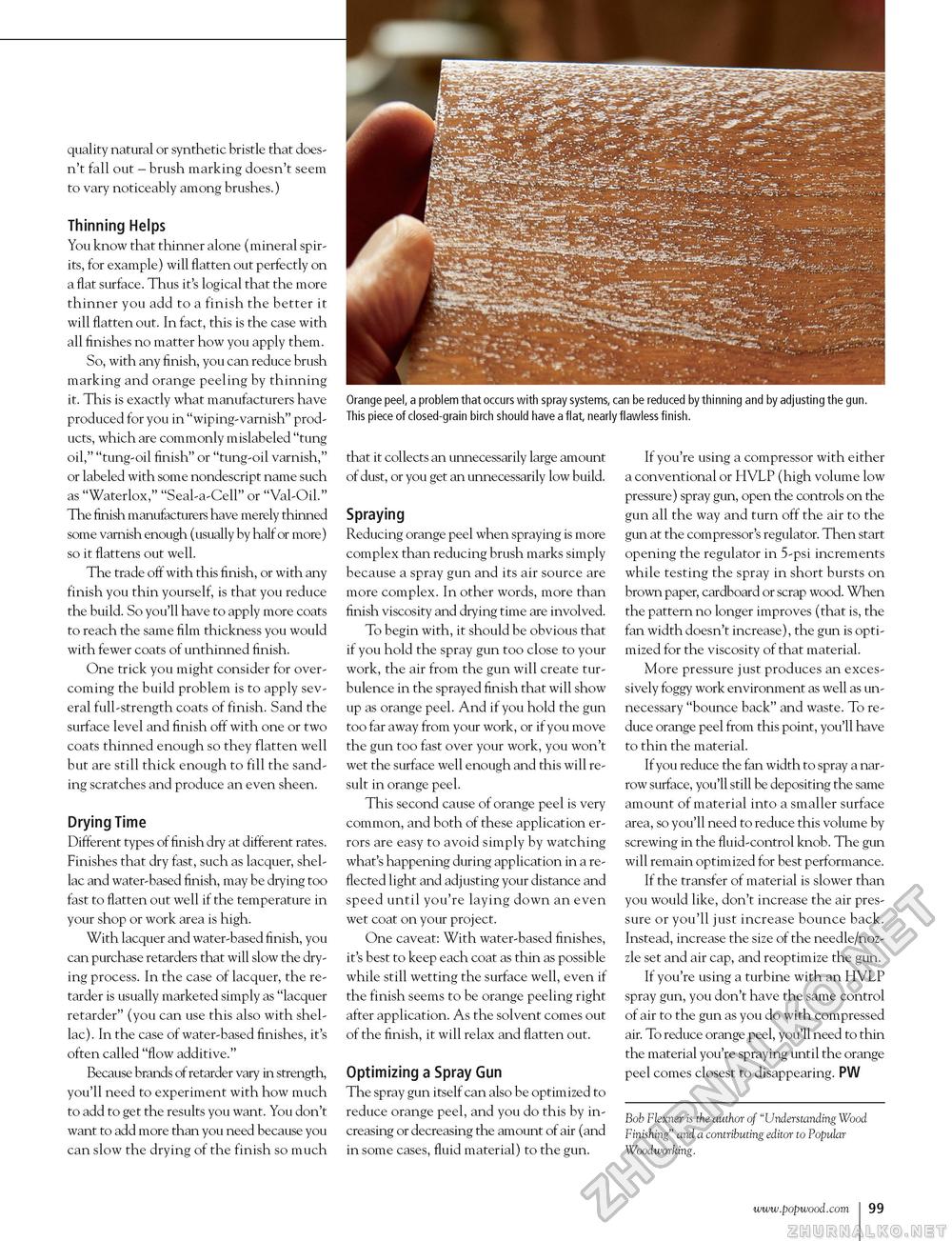Popular Woodworking 2002-12 № 131, страница 94
quality natural or synthetic bristle that doesn't fall out - brush marking doesn't seem to vary noticeably among brushes.) Thinning Helps You know that thinner alone (mineral spirits, for example) will flatten out perfectly on a flat surface. Thus it's logical that the more thinner you add to a finish the better it will flatten out. In fact, this is the case with all finishes no matter how you apply them. So, with any finish, you can reduce brush marking and orange peeling by thinning it. This is exactly what manufacturers have produced for you in "wiping-varnish" products, which are commonly mislabeled "tung oil," "tung-oil finish" or "tung-oil varnish," or labeled with some nondescript name such as "Waterlox," "Seal-a-Cell" or "Val-Oil." The finish manufacturers have merely thinned some varnish enough (usually by half or more) so it flattens out well. The trade off with this finish, or with any finish you thin yourself, is that you reduce the build. So you'll have to apply more coats to reach the same film thickness you would with fewer coats of unthinned finish. One trick you might consider for overcoming the build problem is to apply several full-strength coats of finish. Sand the surface level and finish off with one or two coats thinned enough so they flatten well but are still thick enough to fill the sanding scratches and produce an even sheen. Drying Time Different types of finish dry at different rates. Finishes that dry fast, such as lacquer, shellac and water-based finish, may be drying too fast to flatten out well if the temperature in your shop or work area is high. With lacquer and water-based finish, you can purchase retarders that will slow the drying process. In the case of lacquer, the re-tarder is usually marketed simply as "lacquer retarder" (you can use this also with shellac). In the case of water-based finishes, it's often called "flow additive." Because brands of retarder vary in strength, you'll need to experiment with how much to add to get the results you want. You don't want to add more than you need because you can slow the drying of the finish so much Orange peel, a problem that occurs with spray systems, can be reduced by thinning and by adjusting the gun. This piece of closed-grain birch should have a flat, nearly flawless finish. that it collects an unnecessarily large amount of dust, or you get an unnecessarily low build. Spraying Reducing orange peel when spraying is more complex than reducing brush marks simply because a spray gun and its air source are more complex. In other words, more than finish viscosity and drying time are involved. To begin with, it should be obvious that if you hold the spray gun too close to your work, the air from the gun will create turbulence in the sprayed finish that will show up as orange peel. And if you hold the gun too far away from your work, or if you move the gun too fast over your work, you won't wet the surface well enough and this will result in orange peel. This second cause of orange peel is very common, and both of these application errors are easy to avoid simply by watching what's happening during application in a reflected light and adjusting your distance and speed until you're laying down an even wet coat on your project. One caveat: With water-based finishes, it's best to keep each coat as thin as possible while still wetting the surface well, even if the finish seems to be orange peeling right after application. As the solvent comes out of the finish, it will relax and flatten out. Optimizing a Spray Gun The spray gun itself can also be optimized to reduce orange peel, and you do this by increasing or decreasing the amount of air (and in some cases, fluid material) to the gun. If you're using a compressor with either a conventional or HVLP (high volume low pressure) spray gun, open the controls on the gun all the way and turn off the air to the gun at the compressor's regulator. Then start opening the regulator in 5-psi increments while testing the spray in short bursts on brown paper, cardboard or scrap wood. When the pattern no longer improves (that is, the fan width doesn't increase), the gun is optimized for the viscosity of that material. More pressure just produces an excessively foggy work environment as well as unnecessary "bounce back" and waste. To reduce orange peel from this point, you'll have to thin the material. If you reduce the fan width to spray a narrow surface, you'll still be depositing the same amount of material into a smaller surface area, so you'll need to reduce this volume by screwing in the fluid-control knob. The gun will remain optimized for best performance. If the transfer of material is slower than you would like, don't increase the air pressure or you'll just increase bounce back. Instead, increase the size of the needle/nozzle set and air cap, and reoptimize the gun. If you're using a turbine with an HVLP spray gun, you don't have the same control of air to the gun as you do with compressed air. To reduce orange peel, you'll need to thin the material you're spraying until the orange peel comes closest to disappearing. PW Bob Flexner is the author of "Understanding Wood Finishing" and a contributing editor to Popular Woodworking. 99 |








